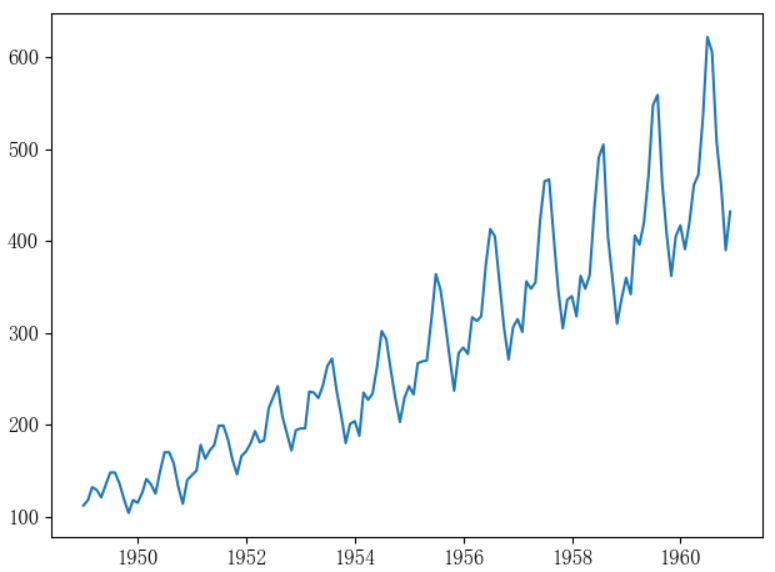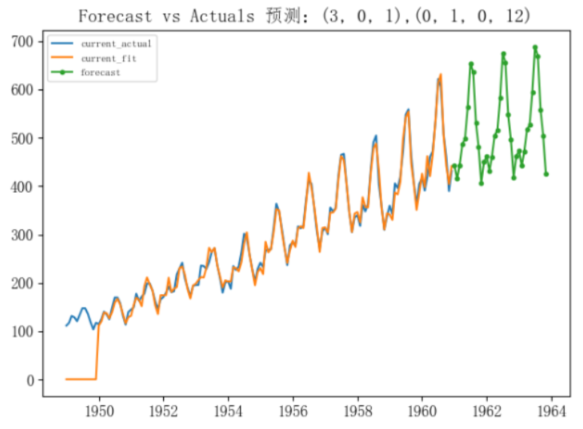本文以航司乘客數預測的例子來組織相關時間序列預測的代碼,通過了解本文中的代碼,當遇到其它場景的時間序列預測亦可套用。
航司乘客數序列

預測步驟
# 加載時間序列數據
_ts = load_data()
# 使用樣本熵評估可預測性
print(f'原序列樣本熵:{SampEn(_ts.values, m=2, r=0.2 * np.std(_ts.values))}')
# 檢驗平穩性
use_rolling_statistics(_ts) # rolling 肉眼
use_df(_ts) # Dickey-Fuller Test 量化
# 平穩變換
_ts_log, _rs_log_diff = transform_stationary(_ts)
# 使用樣本熵評估可預測性
print(f'平穩變換后的序列樣本熵:{SampEn(_ts.values, m=2, r=0.2 * np.std(_ts.values))}')
# acf,pacf定階分析
order_determination(_rs_log_diff)
# plot_lag(_rs)# lag plot(滯后圖分析相關性)
# 構建模型
_fittedvalues, _fc, _conf, _title = build_arima(
_ts_log) # 這里只傳取log后的序列是因為后面會通過指定ARIMA模型的參數d=1來做一階差分,這樣在預測的時候,就不需要手動做逆差分來還原序列,而是由ARIMA模型自動還原
# 預測,並繪制預測結果圖
transform_back(_ts, _fittedvalues, _fc, _conf, _title)
預測結果

完整代碼
# coding='utf-8'
"""
航司乘客數時間序列數據集
該數據集包含了1949-1960年每個月國際航班的乘客總數。
"""
import numpy as np
from matplotlib import rcParams
from statsmodels.tsa.seasonal import seasonal_decompose
from statsmodels.tsa.statespace.sarimax import SARIMAX
from statsmodels.tsa.stattools import acf, pacf
params = {'font.family': 'serif',
'font.serif': 'FangSong',
'font.style': 'italic',
'font.weight': 'normal', # or 'blod'
'font.size': 12, # 此處貌似不能用類似large、small、medium字符串
'axes.unicode_minus': False
}
rcParams.update(params)
import matplotlib.pyplot as plt
import pandas as pd
# 未來pandas版本會要求顯式注冊matplotlib的轉換器,所以添加了下面兩行代碼,否則會報警告
from pandas.plotting import register_matplotlib_converters
register_matplotlib_converters()
def load_data():
from datetime import datetime
date_parse = lambda x: datetime.strptime(x, '%Y-%m-%d')
data = pd.read_csv('datas/samples/AirPassengers.csv',
index_col='Month', # 指定索引列
parse_dates=['Month'], # 將指定列按照日期格式來解析
date_parser=date_parse # 日期格式解析器
)
ts = data['y']
print(ts.head(10))
plt.plot(ts)
plt.show()
return ts
def use_rolling_statistics(time_series_datas):
'''
利用標准差和均值來肉眼觀測時間序列數據的平穩情況
:param time_series_datas:
:return:
'''
roll_mean = time_series_datas.rolling(window=12).mean()
roll_std = time_series_datas.rolling(window=12).std()
# roll_variance = time_series_datas.rolling(window=12).var()
plt.plot(time_series_datas, color='blue', label='Original')
plt.plot(roll_mean, color='red', label='Rolling Mean')
plt.plot(roll_std, color='green', label='Rolling Std')
# plt.plot(roll_variance,color='yellow',label='Rolling Variance')
plt.legend(loc='best')
plt.title('利用Rolling Statistics來觀測時間序列數據的平穩情況')
plt.show(block=False)
def use_df(time_series_datas):
'''
迪基-富勒單位根檢驗
:param time_series_datas:
:return:
'''
from statsmodels.tsa.stattools import adfuller
dftest = adfuller(time_series_datas, autolag='AIC')
dfoutput = pd.Series(dftest[0:4], index=['Test Statistic', 'p-value', '#Lags Used', 'Number of Observations Used'])
for key, value in dftest[4].items():
dfoutput['Critical Value (%s)' % key] = value
print(dfoutput)
def use_moving_avg(ts_log):
moving_avg_month = ts_log.rolling(window=12).mean()
plt.plot(moving_avg_month, color='green', label='moving_avg')
plt.legend(loc='best')
plt.title('利用移動平均法平滑ts_log序列')
plt.show()
return moving_avg_month
def use_exponentially_weighted_moving_avg(ts_log):
expweighted_avg = ts_log.ewm(halflife=12).mean()
plt.plot(expweighted_avg, color='green', label='expweighted_avg')
plt.legend(loc='best')
plt.title('利用指數加權移動平均法平滑ts_log序列')
plt.show()
return expweighted_avg
def use_decomposition(ts_log):
'''
時間序列分解
:param ts_log:
:return: 去除不平穩因素后的序列
'''
decomposition = seasonal_decompose(ts_log, freq=12)
trend = decomposition.trend
seasonal = decomposition.seasonal
residual = decomposition.resid
plt.subplot(411)
plt.plot(ts_log, label='Original')
plt.legend(loc='best')
plt.subplot(412)
plt.plot(trend, label='Trend')
plt.legend(loc='best')
plt.subplot(413)
plt.plot(seasonal, label='Seasonality')
plt.legend(loc='best')
plt.subplot(414)
plt.plot(residual, label='Residuals')
plt.legend(loc='best')
plt.tight_layout()
plt.show()
# 衡量趨勢強度
r_var = residual.var()
tr_var = (trend + residual).var()
f_t = np.maximum(0, 1.0 - r_var / tr_var)
print(f_t)
# 衡量季節性強度
sr_var = (seasonal + residual).var()
f_s = np.maximum(0, 1.0 - r_var / sr_var)
print(f"-------趨勢強度:{f_t},季節性強度:{f_s}------")
return residual
def transform_stationary(ts):
'''
平穩變換:
消除趨勢:移動平均、指數加權移動平均
有時候簡單的減掉趨勢的方法並不能得到平穩序列,尤其對於高季節性的時間序列來說,此時可以采用differencing(差分)或decomposition(分解)
消除趨勢和季節性:差分、序列分解
:param ts:
:return:
'''
# 利用log降低異方差性
ts_log = np.log(ts)
# plt.plot(ts_log, color='brown', label='ts_log')
# plt.title('ts_log')
# plt.show()
# 移動平均法,得到趨勢(需要確定合適的K值,當前例子中,合適的K值是12個月,因為趨勢是逐年增長,但是有些復雜場景下,K值的確定很難)
# trend = use_moving_avg(ts_log)
# 指數加權移動平均法平,得到趨勢(由於每次都是從當前時刻到起始時刻的指數加權平均,所以沒有確定K值的問題)
# trend = use_exponentially_weighted_moving_avg(ts_log)
# print(trend)
# 減去趨勢:將平滑后的序列從ts_log序列中移除
# rs = ts_log - trend
# 若趨勢建模是用的移動平均法,由於是取前12個月的均值,所以開始的11個值的移動平均都是非數了,需要去除非數
# rs.dropna(inplace=True)
# differencing(差分)
rs_log_diff = ts_log - ts_log.shift() # 1階差分
# use_rolling_statistics(rs)
# rs = rs - rs.shift() # 2階差分
# 季節性差分 ,此案例中的季節間隔為12個月 d=1 D=1
# rs = (ts_log - ts_log.shift(periods=12)) - (ts_log.shift() - ts_log.shift().shift(periods=12))
rs_log_diff.dropna(inplace=True)
# decomposition(分解)
# rs = use_decomposition(ts_log)
# rs.dropna(inplace=True)
# 對去除趨勢后的序列做平穩性檢驗
# use_rolling_statistics(rs)
use_df(rs_log_diff)
return ts_log, rs_log_diff
def order_determination(ts_log_diff):
'''
利用acf和pacf確定模型以及階數
:param ts_log_diff:
:return:
'''
lag_acf = acf(ts_log_diff, nlags=10, fft=False)
lag_pacf = pacf(ts_log_diff, nlags=10, method='ols')
z = 1.96
# z = 1.65
# Plot ACF:
plt.subplot(121)
plt.plot(lag_acf)
plt.axhline(y=0, linestyle='--', color='gray')
plt.axhline(y=-z / np.sqrt(len(ts_log_diff) - 1), linestyle='--',
color='gray') # 利用白噪聲的標准正態分布假設來選擇相關性的置信度區間,1.96是95%置信度下的統計量
plt.axhline(y=z / np.sqrt(len(ts_log_diff) - 1), linestyle='--', color='gray')
plt.title('Autocorrelation Function')
# Plot PACF:
plt.subplot(122)
plt.plot(lag_pacf)
plt.axhline(y=0, linestyle='--', color='gray')
plt.axhline(y=-z / np.sqrt(len(ts_log_diff)), linestyle='--', color='gray')
plt.axhline(y=z / np.sqrt(len(ts_log_diff)), linestyle='--', color='gray')
plt.title('Partial Autocorrelation Function')
plt.tight_layout()
plt.show()
def draw_rss_plot(ts_log_diff, orders, title, freq='MS'):
from statsmodels.tsa.arima_model import ARIMA
model = ARIMA(ts_log_diff, order=orders, freq=freq)
results_fitted = model.fit(disp=-1)
# print(results.summary())
plt.plot(ts_log_diff)
plt.plot(results_fitted.fittedvalues, color='red')
plt.title('%s RSS: %.4f' % (title, sum((results_fitted.fittedvalues - ts_log_diff) ** 2)))
plt.show()
return results_fitted.fittedvalues
def draw_future_plot(ts_log_diff, orders, seasonal_order, title, freq='MS'):
# ARIMA模型
# model = ARIMA(ts_log_diff, order=orders, freq=freq)
# results_fitted = model.fit(disp=-1, trend='c')
# fit_values = results_fitted.fittedvalues
# fc, _, conf = results_fitted.forecast(36, alpha=0.05) # 95% conf
# 季節性ARIMA模型
model = SARIMAX(ts_log_diff, order=orders, seasonal_order=seasonal_order)
results_fitted = model.fit(disp=5)
fit_values = results_fitted.fittedvalues
print(results_fitted.summary())
fc = results_fitted.forecast(36)
conf = None
return fit_values, fc, conf, title
def build_arima(ts_log_diff):
'''
start_params表示ARIMA模型的所有項的參數,包括常數項,AR階數項,MA階數項,隨機誤差項.
'''
# order = (0, 1, 0) # 僅能靠常數的逆差分構建一個趨勢,這里的常數是start_params的第一個元素,是通過一個全一的exog列向量和一個endog列向量做OLS方法得到的一個常數,這個常數其實就是endog向量元素的平均值
# order = (3, 1, 0) # 逆差分構建一個趨勢 + 變量自回歸擬合一定的波動
# order = (0, 1, 3) # 逆差分構建一個趨勢 + 隨機誤差自回歸擬合一定的波動,誤差應該是來自平均值作為預測的誤差,待求證
order = (3, 0, 2) # 變量自回歸擬合一定的波動 + 預測誤差自回歸擬合一定的波動
seasonal_order = (0, 1, 0, 12) # 季節性差分,季節窗口=12個月
# draw_rss_plot(ts_log_diff, order, '擬合:%s' % str(order))
fittedvalues, fc, conf, title = draw_future_plot(ts_log_diff, order, seasonal_order,
'預測:%s,%s' % (str(order), str(seasonal_order)))
return fittedvalues, fc, conf, title
def transform_back(ts, fittedvalues, fc, conf, title):
'''
變換回平穩變換之前的狀態,以便預測目標觀測值
:param ts: 原始序列
:param fittedvalues: 擬合出的序列
:param fc: 預測的未來序列
:return:
'''
# Make as pandas series
future_index = pd.date_range(start=ts.index[-1], freq='MS', periods=36)
fc_series = pd.Series(fc, index=future_index)
print(fc_series.head())
print(fittedvalues.head(24))
lower_series, upper_series = None, None
if conf is not None:
lower_series = pd.Series(conf[:, 0], index=future_index)
upper_series = pd.Series(conf[:, 1], index=future_index)
current_ARIMA_log = pd.Series(fittedvalues, copy=True)
future_ARIMA_log = pd.Series(fc_series, copy=True)
# 逆log
current_ARIMA = np.exp(current_ARIMA_log)
future_ARIMA = np.exp(future_ARIMA_log)
# lower_ARIMA = np.exp(lower_log_series)
# upper_ARIMA = np.exp(upper_log_series)
# Plot
plt.figure(figsize=(12, 5), dpi=100)
plt.plot(ts, label='current_actual')
plt.plot(current_ARIMA, label='current_fit')
plt.plot(future_ARIMA, label='forecast', marker='o', ms=3)
if lower_series is not None:
# plt.fill_between(lower_ARIMA.index, lower_ARIMA, upper_ARIMA,color='k', alpha=.15)
pass
plt.title('Forecast vs Actuals %s' % title)
plt.legend(loc='upper left', fontsize=8)
plt.show()
def plot_lag(rs):
from pandas.plotting import lag_plot
fig, axes = plt.subplots(1, 4, figsize=(10, 3), sharex=True, sharey=True, dpi=100)
for i, ax in enumerate(axes.flatten()[:4]):
lag_plot(rs, lag=i + 1, ax=ax, c='firebrick')
ax.set_title('Lag ' + str(i + 1))
fig.suptitle('Lag Plots of AirPassengers', y=1.15)
plt.show()
def SampEn(U, m, r):
"""
Compute Sample entropy
用於量化時間序列的可預測性
思想:
返回一個-np.log(A/B),該值越小預測難度越小,所以A/B越大,預測難度越小。
:param U: 時間序列
:param m: 模板向量維數
:param r: 距離容忍度,一般取0.1~0.25倍的時間序列標准差,也可以理解為相似度的度量閾值,小於這個閾值的2個向量被認為是相似的
:return: 返回一個-np.log(A/B),該值越小預測難度越小,所以A/B越大,預測難度越小。 一般可以和同等長度的隨機序列的結果比較,小於這個結果,則具備一定的可預測性
"""
def _maxdist(x_i, x_j):
"""
Chebyshev distance
:param x_i:
:param x_j:
:return:
"""
return max([abs(ua - va) for ua, va in zip(x_i, x_j)])
def _phi(m):
x = [[U[j] for j in range(i, i + m - 1 + 1)] for i in range(N - m + 1)]
C = [len([1 for j in range(len(x)) if i != j and _maxdist(x[i], x[j]) <= r]) for i in range(len(x))]
return sum(C)
N = len(U)
return -np.log(_phi(m + 1) / _phi(m))
if __name__ == '__main__':
# 加載時間序列數據
_ts = load_data()
# 使用樣本熵評估可預測性
print(f'原序列樣本熵:{SampEn(_ts.values, m=2, r=0.2 * np.std(_ts.values))}')
# 檢驗平穩性
use_rolling_statistics(_ts) # rolling 肉眼
use_df(_ts) # Dickey-Fuller Test 量化
# 平穩變換
_ts_log, _rs_log_diff = transform_stationary(_ts)
# 使用樣本熵評估可預測性
print(f'平穩變換后的序列樣本熵:{SampEn(_ts.values, m=2, r=0.2 * np.std(_ts.values))}')
# acf,pacf定階分析
order_determination(_rs_log_diff)
# plot_lag(_rs)# lag plot(滯后圖分析相關性)
# 構建模型
_fittedvalues, _fc, _conf, _title = build_arima(
_ts_log) # 這里只傳取log后的序列是因為后面會通過指定ARIMA模型的參數d=1來做一階差分,這樣在預測的時候,就不需要手動做逆差分來還原序列,而是由ARIMA模型自動還原
# 預測,並繪制預測結果圖
transform_back(_ts, _fittedvalues, _fc, _conf, _title)
小結
陸陸續續寫了10篇時間序列相關的文章了,本系列主要是應用為主,包括初識概念、時間序列數據可視化、時間序列分解、平穩/非平穩時間序列、時間序列缺失值處理、相關函數圖/偏相關函數圖/滯后圖、時間序列復雜度量化、Granger causality test(格蘭傑因果檢驗)、ARIMA模型簡介、時間序列實踐-航司乘客數預測。
暫時先記錄到這里,后續應該還會補充一些,比如基於深度學習的時間序列預測等。
ok,本篇就這么多內容啦~,感謝閱讀O(∩_∩)O。

